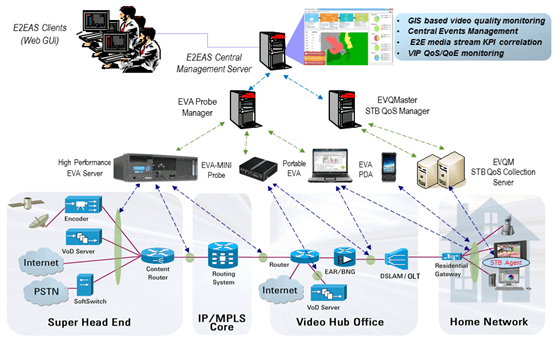End-to-End IP Video Service Quality Assurance
In recent years, with rapid development of IP networks and applications, IPTV and OTT (Over The Top) technology based mobile video and multi-screen interactive services are growing rapidly through smartphones, tablets, PCs and connected TVs. The IP video content consumption of the machine is growing at an amazing rate. Among them, the new generation of HTTP adaptive streaming technology (such as: HLS-HTTP Live Streaming advocated by Apple) can automatically request the appropriate video quality (eg. different resolution and code rate) from the video server according to the screen size of the terminal and the available network bandwidth, thereforeprovidesthe best video watching experience to users. Now, OTT/HLS video is widely regarded as the core technology for multi-screen interaction in the industry and has broad application prospects.
As three different digital video services, IPTV, OTT Internet TV, and NGB next-generation cable TV are bound to compete. In addition to rich program content and price factors, how to ensure the quality of user experience can be a key factor in the success of different video services. Due to the end-to-end IP video service transmission, the network equipment of multiple participants (including content providers, CDN providers, network operators and user home networks) can reach the end users, which guarantees the quality of IP video services. That brings many new difficulties and challenges: How to objectively evaluate and measure the quality of experience (QoE) of end users on IP video? How to quickly diagnose and locate the IP video service quality problem? How to verify the quality of user experience with multi-screen interaction?
Dekscom EyeNet’s end-to-end IP video quality monitoring system provides comprehensive IPTV, OTT Internet TV, NGB next-generation broadcast TV service quality monitoring and fault diagnosis solutions, which can help telecom and broadcasting operators accelerate the development, deployment and promotion of IP video services. In addition, the system helps effectively monitor and diagnose various IP video service quality issues in wireline and wireless networks. Various types of hardware probes and QoS agents can be deployed on network nodes such as IP video source servers, CDN cache servers, IP bearer networks, set-top boxes at home networks, or mobile terminals for end-to-end IP video QoS/QoE monitoring, which quickly locates the root cause of IP video quality degradation and service failures.




